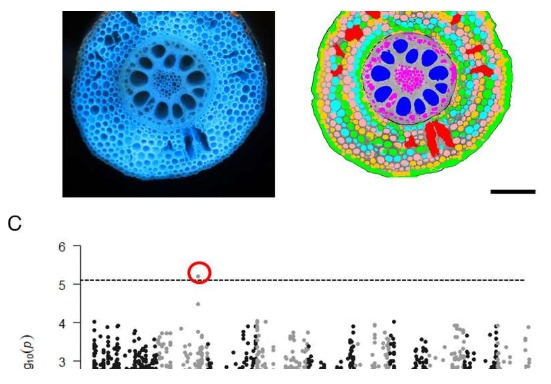Researchers have revealed for the first time how a key gene in plants allows them to use their energy more efficiently, enabling them to grow more roots and capture more water and nutrients.

Identification of mutant locus associated with root cortical aerenchyma in maize roots. (A) An image of root cross-sectional surface captured by laser ablation tomography (LAT). (B) Root anatomical phenotypes were quantified by RootScan software. (C) Manhattan plot of GWAS results for root cortical aerenchyma. Chromosome-wide significance threshold (horizontal line) was set using the simpleM method (−log10p = 5.32). Significant SNPs were located in gene model GRMZM2G083504 (ZmbHLH121) encoding a ZmbHLH121 transcription factor. (D) Relative expression of ZmbHLH121 in the stele and cortex of a primary root from a 3-d-old maize seedling.
An international team of plant scientists led by Penn State University and in collaboration with the University of Nottingham have discovered this novel regulatory gene (called bHLH121) that enables corn roots to acquire more water and nutrients. The findings have been published in the Proceedings of the National Academy of Science.
The gene controls the formation of air spaces among living root tissues (termed root cortical aerenchyma). Replacing a large percentage of root cells with airspaces saves the plant a lot of energy which is otherwise required to feed all these root cells. This makes roots metabolically more efficient, enabling them to use the resources saved to build more roots and explore the soil more effectively and capture more water and nutrients.
This discovery could lead to the breeding of crops that can withstand drought and low-nitrogen soil conditions and ultimately ease global food insecurity, the researchers suggest.
"Identifying this gene and how it works will enable us to create more resilient crops that can withstand water and nutrient stress conditions being experienced as a result of climate change," says Rahul Bhosale, Assistant Professor in Crop Functional Genomics from the School of Biosciences and BBSRC Discovery Fellow.
The research team used powerful imaging tools developed in previous research at Penn State that rapidly measured cells in thousands of roots. An imaging technique called Laser Ablation Tomography was critical for this approach. This state-of-the-art approach is also now available at the University of Nottingham.
Hannah Schneider, Assistant Professor of Crop Physiology at Wageningen University & Research, Netherlands said, "We first performed the field experiments that went into this study starting in 2010, growing more than 500 lines of corn at sites in Pennsylvania, Arizona, Wisconsin and South Africa," she said. "I worked at all those locations. We saw convincing evidence that we had located a gene associated with root cortical aerenchyma."
This research revealed that mutant corn lines lacking the bHLH121 gene showed reduced root air space formation. In contrast, overexpressing bHLH121 caused more air space formation.
Characterization of these lines under suboptimal water and nitrogen availability in multiple locations revealed that the bHLH121 gene is required for root air space formation and provides a new tool for plant breeders to select varieties with improved soil exploration, and thus yield, under suboptimal conditions.
Click here to see more...